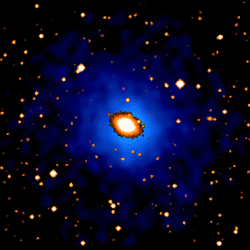April 7, 2005
RAS RELEASE PN 05/24

Nearest Fossil Group: Chandra X-ray observations of the giant elliptical galaxy NGC 6482, at the centre of this image, show that it is surrounded by a cloud of hot gas (shown in blue), which has a temperature of about 10 million degrees Celsius and measures over 700,000 light years across. This giant galaxy is believed to have grown to its present size by cannibalising its neighbours, leaving only the X-ray halo to tell the tale.
Researchers at the University of Birmingham have used the new generation of X-ray space observatories to study "fossil galaxies" - ancient galaxy groups in which all of the large galaxies have gradually merged to form one central giant galaxy.
The astronomers discovered a remarkable concentration of dark and normal matter in the cores of these isolated star systems, compared with the mass distribution in normal galaxy groups.
Many galaxies, including our Milky Way, reside in groups. Sometimes they experience close encounters with other members of the group. Computer simulations predict that such interactions cause large galaxies to spiral slowly towards the centre of the group, where they can merge to form a single giant galaxy, which progressively swallows all its neighbours.
Since many galaxy groups possess extended halos of hot gas and dark matter, it was predicted ten years ago that a class of systems dubbed "fossil groups" should exist, in which all the major galaxies have merged to form one central giant galaxy. This would be surrounded by an X-ray-bright cloud of hot gas that extends outward to many galactic radii.
"When we first discovered the large halos of hot gas in which some very compact groups of galaxies are embedded, we realised that just a few billion years of further evolution would leave a single, giant, merged galaxy sitting at the centre of a bright X-ray halo," said Trevor Ponman, the leader of the Birmingham group who made this prediction and then discovered the first fossil group in 1994.
Theories also suggested that fossil groups which fall into even larger clusters of galaxies may account for the giant elliptical galaxies which are often found in the centres of such clusters.
The Birmingham team has observed six likely "fossil groups" in the past two years, taking advantage of the sharp vision of NASA's Chandra X-Ray Space Observatory and the high sensitivity of ESA's orbiting XMM-Newton X-ray observatory. The six "fossil groups" are located up to two billion light years from Earth. The team's main objective was to explore the mechanisms by which fossil groups and giant elliptical galaxies are formed.
The key to the study was the distribution of dark matter in the fossil groups. This mysterious matter comprises over 80 per cent of the mass of the Universe, yet its nature is unknown. Dark matter has never been detected directly, but its presence is inferred through its gravitational influence on ordinary matter.
The large elliptical galaxy NGC 6482 was of special interest to the team, since it is the closest known fossil group, and could be studied in great detail. This isolated giant, which shines with the equivalent of 110 billion Suns, is located 100 million light years away in the constellation Hercules.
Using Chandra's Advanced CCD Imaging Spectrometer, Habib Khosroshahi, Trevor Ponman and Laurence Jones, used observations of the hot gas to trace the distribution of dark matter in NGC 6482. The gas is heated to a temperature of 10 million degrees Celsius, mainly due to shock heating as a result of gravitational collapse.
Speaking today at the RAS National Astronomy Meeting in Birmingham, Habib Khosroshahi described the discovery of a remarkable concentration of dark matter in the core of NGC 6482.
Khosroshahi also described two more examples of high mass concentration in more massive and more distant fossil galaxies studied by both the Chandra and the XMM-Newton telescopes, although the case of NGC 6482 is unique, since it is possible to probe the centre of the system with higher accuracy.
According to Khosroshahi, the concentration of mass at the centre of these ancient galaxy groups, which is mostly in the form of dark matter, was found to be typically five times higher than in normal galaxy groups with similar mass and halo size.
This central concentration of mass supports the idea that fossil groups such as NGC 6482 are very old structures which collapsed long before the typical groups of galaxies formed.
"The explanation for such a centralised dark matter distribution could be that the system formed at very high redshift - when the Universe was very young and dense," said Khosroshahi.
"The great advantage of fossil groups compared to normal groups is that no major galaxy interaction, which can stir the hot gas, is taking place," he added. "Therefore, they provide ideal laboratories to study the properties of visible matter in the form of gas and stars as well as their container, the dark matter."
Additional information and images are available at:
MEDIA CONTACTS
Peter Bond
Phone: +44 (0)1483-268672
Anita Heward
Phone: +44 (0)1483-420904


